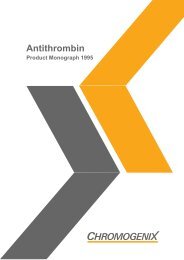Plasminogen - Chromogenix
Plasminogen - Chromogenix
Plasminogen - Chromogenix
You also want an ePaper? Increase the reach of your titles
YUMPU automatically turns print PDFs into web optimized ePapers that Google loves.
NH 2<br />
<strong>Plasminogen</strong>, version 1.1<br />
F<br />
NH 2<br />
EGF<br />
EGF<br />
46<br />
Single-chain t-PA is a 68 kDa glycoprotein,<br />
consisting of 530 amino acids and containing 7-13%<br />
carbohydrate. In human plasma, t-PA occurs mainly<br />
as a complex together with its principal inhibitor<br />
PAI-1. The level of t-PA antigen is about 5 μg/ml,<br />
whereas the concentration of free t-PA is only about<br />
1 μg/l or 0.5 IU/ml (specific activity range 500,000<br />
to 700,000 U/mg). The single-chain t-PA molecule is<br />
converted by plasmin to a two-chain form by cleavage<br />
of the Arg 275 -Ile 276 peptide bond. Binding to<br />
fibrin concentrates and correctly orientates t-PA and<br />
plasminogen, as well as inducing conformational<br />
changes in the molecules that promote efficient clot<br />
lysis.<br />
Urokinase<br />
275<br />
K1 K2 P<br />
158<br />
K1<br />
156<br />
P<br />
Urokinase-type plasminogen activator (u-PA) is<br />
mainly produced in the kidneys as an inactive<br />
single-chain molecule (scu-PA). u-PA has its major<br />
function in tissue-related proteolysis and is believed<br />
to play only a secondary role to t-PA as a physiological<br />
activator in blood.<br />
The activation of scu-PA by catalytic amounts of<br />
plasmin results in a two-chain structure with increased<br />
activity towards plasminogen. Through this<br />
mechanism, initial traces of plasmin may catalyze<br />
the production of active u-PA, leading to the formation<br />
of more plasmin. u-PA can only activate plasminogen<br />
in the presence of fibrin. However, it does<br />
135<br />
143<br />
COOH<br />
411<br />
Biochemistry<br />
COOH<br />
530<br />
7<br />
Figure 3. Domain structures of t-PA and u-PA.<br />
The t-PA molecule is composed of at least five domains: a finger<br />
domain, the epidermal growth factor domain (EGF), two kringle<br />
domains and the protease domain. The u-PA molecule consists<br />
of a EGF domain, one kringle and the protease domain. The<br />
finger domain is homologous to structures found in fibronectin.<br />
In the t-PA molecule this domain is implicated with fibrin<br />
binding. The EGF domain often confers affinity to specific<br />
receptors on cell surfaces.<br />
not bind to fibrin and is not activated by fibrin. In<br />
human plasma, u-PA antigen concentrations range<br />
from 2 to 7 ng/ml. Higher values are often found in<br />
patients with liver cirrhosis and hepatoma.<br />
Streptokinase<br />
Streptokinase (SK) is an exogenous plasminogen<br />
activator of 47 kDa, derived from streptococci<br />
bacteria. It is not an enzyme and functions by<br />
forming a stoichiometric 1:1 complex with human<br />
plasminogen.This complex can function as an<br />
activator of other plasminogen molecules. Complex<br />
formation is accompanied by a conformational<br />
change in the plasminogen molecule, exposing the<br />
active site to activate a second plasminogen molecule<br />
and is followed by the conversion of the SKplasminogen<br />
into a SK-plasmin complex. Both types<br />
of SK-complexes are equally efficient activators of<br />
plasminogen (Figure 4).<br />
SK + Pg [SK•Pg]<br />
[SK•Pg] + Pg [SK•Pm] + Pm<br />
[SK•Pm] + Pg [SK•Pm] + Pm<br />
Figure 4. The sequence of streptokinase (SK), human plasminogen<br />
(Pg) and plasmin (Pm) reactions. 8



